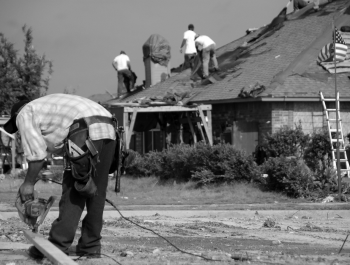Image

Roland Chupik, Executive Director, Neighborhood Housing Services of Oklahoma City
Challenge: Soon after tornadoes struck Moore, Oklahoma, the extent of the devastation was apparent. Entire blocks and neighborhoods were flattened or heavily damaged, including two elementary schools, and 24 people were killed. Less than two weeks later, a second twister with winds exceeding 200 mph struck western Oklahoma City and El Reno, Oklahoma. It killed more than 20 people and went on record as the widest tornado ever recorded.
Tornados are common across the Oklahoma landscape with dozens touching down across the state each year. But the 2013 tornado season was different. In Moore, OK that year a category E5 tornado – the most powerful measure -- hit with winds exceeding 200 miles per hour and led to the loss of more than 20 lives and $2 billion of residential and commercial devastation not seen before.
The town of Moore is within our service area and we knew that we had to do what we could to help the thousands of families who had lost everything, including their homes. As we were planning our next steps, we realized that we didn’t have the financial resources to do all that we wanted to do. That’s where having a relationship with NeighborWorks America, a national nonprofit community development organization was essential.
Preliminary damage estimates were coming in as we stayed in touch with NeighborWorks and together we concluded that the best course of action for us was to focus on immediate housing issues. Housing is our business; that’s where we would place our attention.
A major part of our energy in this first phase of post-disaster activity was directed at helping residents work with the Federal Emergency Management agency, insurance companies, mortgage lenders and other that were providing financial assistance. Each of these organizations had its own forms, processes and guidelines. A dizzying array of information was required from each homeowner. Because of housing counseling experience at the NHSOKC, we were able to help people navigate the process a bit easier. NHSOKC staff immediately jumped into action and offered our help to homeowners applying for assistance and completing insurance claims.
The going was slow and tough, but progress could be measured.
The reality of the situation crystalized in conversations with residents. We learned that the emotional impact of losing your home is almost impossible to imagine. Most homeowners are overwhelmed with that loss, which can make it difficult to shift gears to start the recovery process. But applying for assistance is only part of the challenge. Where were the more than 12,000 people whose homes were damaged and the more than 1,400 whose houses were completely gone to live?
 In the second phase of response, we worked to secure temporary and permanent housing. Using a $100,000 grant from NeighborWorks America and donations of 15 foreclosed properties by J.P. Morgan Chase and Bank of America, we were able to quickly offer real, tangible housing help.
In the second phase of response, we worked to secure temporary and permanent housing. Using a $100,000 grant from NeighborWorks America and donations of 15 foreclosed properties by J.P. Morgan Chase and Bank of America, we were able to quickly offer real, tangible housing help.In addition to the grant helping NHSOKC to immediately start fixing up homes so that some of the families who lost their homes have a place to live, the cash helped the organization pursue funds from other funding sources, so that we can rehab all 15 donated homes as quickly as possible.
With needs in the immediate aftermath of the tornado being addressed from a variety of angles and with a plethora of different resources, NHSOKC began to strategize about preparing for the next disaster.
There would be another tornado in the region; Oklahoma ranks third in the number of tornados that touch down. Thankfully, many of these storms are not in places as populated as Moore, but it takes only one massive event to ruin thousands of lives. We took it on as our job to help mitigate future disaster.
This third phase of the recovery effort is focused on a critical, long-term need: storm shelters. Again, here is where a nonprofit like NHHOKC was fortunate to have a partner who is aligned with our goals. NeighborWorks America also is affiliated with two other nonprofits in Oklahoma -- the Community Action Project of Tulsa and the Little Dixie Community Action Agency in Hugo. Together we worked to develop strategies for building storm shelters in existing single-family homes and multi-family projects, and for incorporating storm shelters into future developments.
It’s not enough to rebuild; it’s important that all of us rebuild better.
The collaborative and multi-pronged approach to dealing with post-tornado housing in Oklahoma is a model for disaster response everywhere. Assessment of community needs by multiple local stakeholders that is supported by a national organization is a solid way forward, one that is working for us and we believe would work elsewhere, too.

